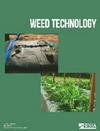Simulation-based nozzle density optimization for maximized efficacy of a machine-vision weed control system for applications in turfgrass settings
IF 1.7
3区 农林科学
Q3 AGRONOMY
引用次数: 0
Abstract
Targeted spray application technologies have the capacity to drastically reduce herbicide inputs, but to be successful, the performance of both machine vision (MV) based weed detection and actuator efficiency need to be optimized. This study assessed 1) the performance of spotted spurge recognition in ‘Latitude 36’ bermudagrass turf canopy using the You Only Look Once (YOLOv3) real-time multi-object detection algorithm, and 2) the impact of various nozzle densities on model efficiency and projected herbicide reduction under simulated conditions. The YOLOv3 model was trained and validated with a dataset of 1,191 images. The simulation design consisted of 4 grid matrix regimes (3 × 3, 6 × 6, 12 × 12, and 24 × 24), which would then correspond to 3, 6, 12, and 24 non-overlapping nozzles, respectively, covering a 50-cm wide band. Simulated efficiency testing was conducted using 50 images containing predictions (labels) generated with the trained YOLO model and, by applying each of the grid matrixes to individual images. The model resulted in prediction accuracy of a基于仿真的喷嘴密度优化,使机器视觉除草系统在草坪应用中发挥最大功效
定向喷洒技术能够大幅减少除草剂的投入,但要取得成功,必须优化基于机器视觉(MV)的杂草检测性能和执行器效率。本研究评估了:1)使用 You Only Look Once (YOLOv3) 实时多目标检测算法识别 "纬度 36 "百慕大草草皮冠层中斑刺草的性能;2)在模拟条件下,各种喷嘴密度对模型效率和预计除草剂减少量的影响。YOLOv3 模型由 1,191 幅图像组成的数据集进行训练和验证。模拟设计包括 4 种网格矩阵制度(3 × 3、6 × 6、12 × 12 和 24 × 24),分别对应 3、6、12 和 24 个非重叠喷嘴,覆盖 50 厘米宽的区域。模拟效率测试使用了 50 幅图像,其中包含使用训练有素的 YOLO 模型生成的预测结果(标签),并将每个网格矩阵应用于单个图像。该模型的预测准确度为 F1 分数 0.62,精确度为 0.65,召回值为 0.60。喷嘴密度的增加(从 3 个增加到 12 个)提高了执行器的精度和除草剂的预测使用效率,误命中率从 30% 降至 5%。确保图像中检测到的所有斑刺玫都能喷洒除草剂所需的面积减少到 18%,与播撒施药相比,可节省 80% 的除草剂。24 个喷嘴的预测精度略高,但与 12 个喷嘴的方案没有统计学差异。以该草坪/杂草模型为基础,通过将喷嘴密度从 1 个增加到 12 个,并在单带范围内使用,可达到最佳执行器功效并节省除草剂。
本文章由计算机程序翻译,如有差异,请以英文原文为准。
求助全文
约1分钟内获得全文
求助全文
来源期刊

Weed Technology
农林科学-农艺学
CiteScore
2.90
自引率
21.40%
发文量
89
审稿时长
12-24 weeks
期刊介绍:
Weed Technology publishes original research and scholarship in the form of peer-reviewed articles focused on understanding how weeds are managed.
The journal focuses on:
- Applied aspects concerning the management of weeds in agricultural systems
- Herbicides used to manage undesired vegetation, weed biology and control
- Weed/crop management systems
- Reports of new weed problems
-New technologies for weed management and special articles emphasizing technology transfer to improve weed control
-Articles dealing with plant growth regulators and management of undesired plant growth may also be accepted, provided there is clear relevance to weed science technology, e.g., turfgrass or woody plant management along rights-of-way, vegetation management in forest, aquatic, or other non-crop situations.
-Surveys, education, and extension topics related to weeds will also be considered
 求助内容:
求助内容: 应助结果提醒方式:
应助结果提醒方式:


